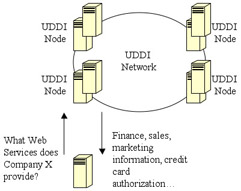9.3 Universal Description, Discovery, and Integration (UDDI)
|
| < Day Day Up > |
|
UDDI is another delightful set of letters that forms part of the .NET acronym jungle. UDDI is not a Microsoft-owned initiative and is actually stronger due to the fact that a number of industry organizations are supporting the UDDI initiative as the way for a business to do the following:
-
Describe its services
-
Discover other businesses offering services
-
Provide a framework to integrate into other businesses electronically
A good analogy is a typical set of telephone directories. In a number of countries there are three types of business directories: white pages of business contact information; yellow pages, which categorize businesses by agreed taxonomies; and green pages, which document the information about available services.
Imagine wading through thousands of businesses in white pages trying to determine whether the business is suitable to work with, and then have to decide the best way to interface with the technology a business may have in place. UDDI is designed to make the searching of online businesses and, once you have found your business partner, describing the best way to interface with its systems much easier.
UDDI is designed to reduce the cost of setting up a business-to-business environment and help integrate disparate business processes (see Figure 9.4).

Figure 9.4: UDDI network with nodes containing copies of registered Web service information.
UDDI is platform- and vendor-independent, enabling anyone to adopt this standard as a way to describe a business venture. In terms of the technology employed, UDDI is based on XML, SOAP, and HTTP and does not introduce a new technology-rather, it suggests a standard way of using what we have. The companies behind UDDI (which include Microsoft, IBM, Oracle, SAP AG, and some other key players in the industry) have not set themselves up as another standards body-instead, they are actively working with W3C and IETF to ratify the UDDI initiative.
UDDI open draft version 1 was published on September 6, 2000, with two subsequent versions issued after nine-month periods before final standards submission.
UDDI Business Registry
The registry is the central hub of UDDI and provides the repository for information about businesses and services they provide. This, in turn, is used by those wishing to search for business partners. Any business can register, but the main purpose of UDDI is to assist businesses looking for Web services.
The UDDI business registry has not been designed to compete with any current business registries; instead, it will focus on providing a global, highlevel repository, referring any detailed searches to local repositories.
The registry is currently run as a distributed service by IBM, Microsoft, and HP-all of which signed a service-level agreement to guarantee system availability; this is overseen by an operator's council, which polices the network.
Each 'node operator,' as they are called, runs a registry service containing a full and up-to-date listing of UDDI entries, with new entries being replicated to each node to ensure the systems are synchronized, in a manner similar to the Domain Name Service on the Internet, but on a (currently) much smaller scale. The replication of the services is through a set of common APIs agreed upon by the operator's council.
To achieve a listing on UDDI, a business must apply through a UDDI registrar, who will take the core business information and translate it into 'UDDI speak' for the central repository.
There are four types of information stored in the registry:
-
Business entity . This contains the base information concerning a business. Each entity will have a unique identifier, the business name, a description of the business, contact information, a URL to the company's Web site, and a list of categories and identifiers describing the business it does.
-
Business service . Each business entity will have a list of services or things it can do. Each of these entries has a business description, a list of categories, and a list of pointers to references and information relating to the services.
-
Specification pointers . Each of the business service entries has a list of templates pointing to technical information about a particular service. Typically this would point to a URL, which, in turn, supplies information on how a service is invoked. The specification pointer will also link a service to a service type.
-
Service type . UDDI uses a tModel, which is metadata about a specification, to define a service type. Any number of businesses can offer the same type of service as defined in the tModel. The tModel will specify the information, such as the tModel name, publishing organization, message formats, message protocols, and security protocols.
Searching the registry is straightforward since it supports both a Webbased interface and an API. All of the taxonomies and classification schemes are based on industry standard categories, and a business can be searched on industry, product category, and geographical location.
|
| < Day Day Up > |
|
EAN: 2147483647
Pages: 136